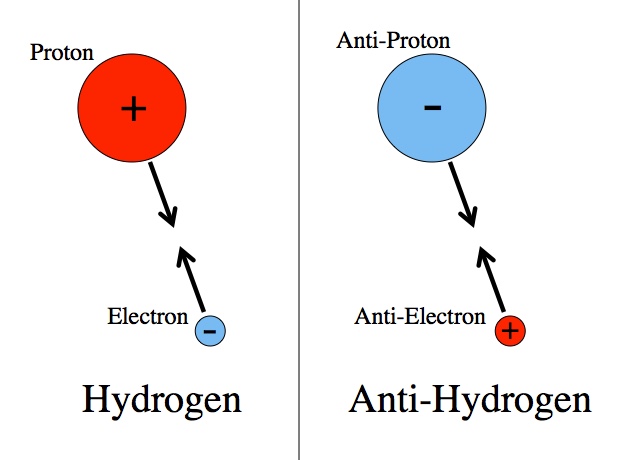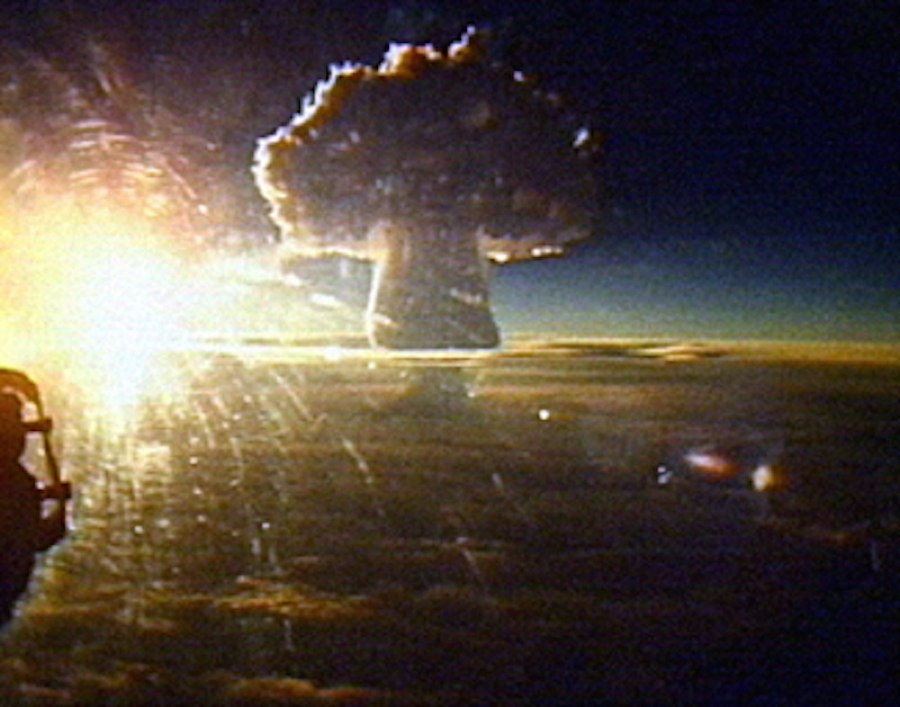Physicist: Anti-matter is exactly the same as ordinary matter but opposite, in very much the same way that a left hand is exactly the same as a right hand… but opposite. Every anti-particle has exactly the same mass as their regular-particle counterparts, but with a bunch of their other characteristics flipped. For example, protons have an electric charge of +1 and a baryon number of +1. Anti-protons have an electric charge of -1 and a baryon number -1. The positive/negativeness of these numbers are irrelevant. A lot like left and right hands, the only thing that’s important about positive charges is that they’re the opposite of negative charges.

Hydrogen is stable because its constituent particles have opposite charges and opposites attract. Anti-hydrogen is stable for exactly the same reason.
Anti-matter acts, in (nearly) every way we can determine, exactly like matter. Light (which doesn’t have an anti-particle) interacts with one in exactly the same way as the other, so there’s no way to just look at something and know which is which. The one and only exception we’ve found so far is beta decay. In beta decay a neutron fires a new electron out of its “south pole”, whereas an anti-neutron fires an anti-electron out of its “north pole”. This is exactly the difference between left and right hands. Not a big deal.

Left: A photograph of an actual flower made of regular matter. Right: An artistic representation of a flower made of anti-matter.
So when we look out into the universe and see stars and galaxies, there’s no way to tell which matter camp, regular or anti, that they fall into. Anti-stars would move and orbit the same way and produce light in exactly the same way as ordinary stars. Like the sign of electrical charge or the handedness of hands, the nature of matter and anti-matter are indistinguishable until you compare them.
But you have to be careful when you do, because when a particle comes into contact with its corresponding anti-particle, the two cancel out and dump all of their matter into energy (usually lots of light). If you were to casually grab hold of 1 kg of anti-matter, it (along with 1 kg of you) would release about the same amount of energy as the largest nuclear detonation in history.

The Tsar Bomba from 100 miles away. This is what 2 kg worth of energy can do (when released all at once).
To figure out exactly how much energy is tied up in matter (either kind), just use the little known relation between energy and matter: E=mc2. When you do, be sure to use standard units (kilograms for mass, meters and seconds for the speed of light, and Joules for energy) so that you don’t have to sweat the unit conversions. For 2 kg of matter, E = (2 kg)(3×108 m/s)2 = 1.8×1017 J.
When anti-matter and matter collide it’s hard to miss. We can’t tell whether a particular chunk of stuff is matter or anti-matter just by looking at it, but because we don’t regularly see stupendous space kablooies as nebulae collide with anti-nebulae, we can be sure that (at least in the observable universe) everything we see is regular matter. Or damn near everything. Our universe is a seriously unfriendly place for anti-matter.
So why would we even suspect that anti-matter exists? First, when you re-write Schrödinger’s equation (an excellent way to describe particles and whatnot) to make sense in the context of relativity (the fundamental nature of spacetime) you find that the equation that falls out has two solutions; a sort of left and right form for most kinds of particles (matter and anti-matter). Second, and more importantly, we can actually make anti-matter.
Very high energy situations, like those in particle accelerators, randomly generate new particles. But these new particles are always produced in balanced pairs; for every new proton (for example) there’s a new anti-proton. The nice thing about protons is that they have a charge and can be pushed around with magnets. Conveniently, anti-protons have the opposite charge and are pushed in the opposite direction by magnets. So, with tremendous cleverness and care, the shrapnel of high speed particle collisions can be collected and sorted. We can collect around a hundred million anti-particles at a time using particle accelerators (to create them) and particle decelerators (to stop and store them).
Anti-matter, it’s worth mentioning, is (presently) an absurd thing to build a weapon with. Considering that it takes the energy of a small town to run a decent particle accelerator, and that a mere hundred million anti-protons have all the destructive power of a single drop of rain, it’s just easier to throw a brick or something.
The highest energy particle interactions we can witness happen in the upper atmosphere; to see them we just have to be patient. The “Oh My God Particle” arrived from deep space with around ninety million times the energy of the particle beams in CERN, but we only see such ultra-high energy particles every few months and from dozens of miles away. We bothered to build CERN so we could see (comparatively feeble) particle collisions at our leisure and from really close up.
Those upper atmosphere collisions produce both matter and anti-matter, some tiny fraction of which ends up caught in the Van Allen radiation belts by the Earth’s magnetic field. In all, there are a few nanograms of anti-matter up there. Presumably, every planet and star with a sufficient and stable magnetic field has a tiny, tiny amount of anti-matter in orbit just like we do. So if you’re looking for all natural anti-matter, that’s the place to look.
But if anti-matter and matter are always created in equal amounts, and there’s no real difference between them (other than being different from each other), then why is all of the matter in the universe regular matter?
No one knows. It’s a total mystery. Isn’t that exciting? Baryon asymmetry is a wide open question and, not for lack of trying, we’ve got nothing.
The rose photo is from here.
Update: A commenter kindly pointed out that a little anti-matter is also produced during solar flares (which are definitively high-energy) and streams away from the Sun in solar wind.







Handedness seems a confusing analog for matter vs. anti-matter, though at a deeper level it’s pretty similar.
Maybe not? Maybe the Andromeda galaxy is of antimatter?
Awesome read as always.
Re: it takes the energy of a small town to run a decent particle accelerator
Isn’t the solar wind loaded with antimatter?
https://www.space.com/21889-solar-flares-antimatter-particles.html
“If you were to casually grab hold of 1 kg of anti-matter, it (along with a 1 kg of you) would release about the same amount of energy as the largest nuclear detonation in history.”
I’ve always kind of wondered about this; what would actually happen in this case, physically? In practice, wouldn’t this be more of an extremely powerful sizzle over time than an explosion, seeing as any given atom of the kg of antimatter wouldn’t likely line up with a particle or matter colliding with it? You’d get a bunch of positron/electron reactions as a first event, obviously, but wouldn’t that sudden burst of gamma radiation (and I assume suddenly-free nuclei) create outward pressure that would push the matter and antimatter apart for a moment, until that faded enough for a new set of interactions to occur? I’d think it wouldn’t be one sudden instant reaction because the energy released by each “layer” would be so intense.
If the 3D universe is just a simple surface on a 3-sphere whose s Gravitational constant G(w,x,y,z(,t)) evolves geometrically from a positive maximum to a negative maximum giving the illusion of time then the periodic table will cycle from a natural length of say Zmax to -Zmax. That is for our current Zmax of 92 elements there exists an evolution of our universe with Zmax= -92. What that means is that we are a positive universe whwn Zmax reaches zero we will be a featyreless big crunch universe and when it is -92 we will see an anti matter universe just as viable as our current universe.
The folks in that Universe will one day ask where all the anti- matter is just like we are doing now.
That’s a certainty!
The real uncertainty is how we wrongly interpret geometric evolution as a thing we call time. That is just a hangover of a 3d creature in a 4d (or greater) matrix.
If we were 4d creatures we would know all of this, but topologically 4d creatures could not contain anything as the extra dimension allows all our innards to spill out. So 4d creatures cannot exist in a 3-sphere or 4d geometry.
There maybe ways to test this theory in the spatial component: If we could notionally measure ‘G’ at the Sun’s surface (Parker Probe carrying a radioistope and continuous counter) plus at the heliopause (the RTG’s coming to life again on the Viking probes)
then wwe could infer that there was a time component to ‘G’ as well whichleads to where all the anti matter exists in a time span currently outside our imagination.
This also solves the quantisation of gravity problem and may well lead to some form of time travel in the future.
With gravity and/or magnetism of the opposing charge, do particles and anti particles seek each other out (for lack of a better term) and annihilate each other?
What if there is a fourth spatial dimension? What if our universe(and all the others if they exist) were not continuous but were composed of discrete 3D points(pixels) analogous to the 2D pixels on your computer monitor or TV screen? These 3D pixels would be extremely small at a diameter of the Planck length. The Planck length is the scale at which classical ideas about gravity and space-time cease to be valid, and quantum effects dominate. This is the ‘quantum of length’, the smallest measurement of length with any meaning and roughly equal to 1.6 x 10-35 m. That is really small and is the reason we perceive the universe as continuous and not grainy.
Now, what if these pixels were “locked” into our perceived universe forever. If we looked at each pixel from a simplistic Euclidean perspective each one could be considered the end of a line of pixels and “our” pixels would block the line behind it from view. Take a needle and look at the end. Now point the needle at your eyes. The needle end is visible but the needle, itself, is blocked from view. Such are all of the pixels hidden behind the pixels making up our universe. That is where the fourth spatial dimension exists, from a very simplified perspective.
Now, when the big bang occurred, most of the matter “blew” in our direction forming the universe we perceive. The anti-matter went the other “direction” forming a parallel anti-universe which “clings” to our universe without interacting with us except through gravity, which knows no boundries.
This would explain where all the anti-matter is and also provides an answer to what dark energy and dark matter is.
One note: This parallel anti-universe along with, most likely, infinitely other parallel universes should not be thought of as “separate balloons” that do not touch as they always are depicted. These universes, from our perspective, are in the same three dimensional space that we occupy. Think of the pages of a book, each representing a parallel universe. Now compress them into one page.
Does the determination of whether a particle is normal matter or anti-matter have anything to do with subatomic particle spin? If the Universe is composed of fields, could the very early Universe have had its own intrinsic spin that led to the dominance of matter over anti-matter?
How does gravity play into this scenario? if anti-matter responds to gravity the same as matter why is there anything in the universe today?
@Idran
I thought about including something about that, but the picture was so dramatic. You’re almost certainly right. Every interaction would blow thinks apart and buy a little time. But, they might also mix things around, losing time.
This is exactly the sort of thing you need a big simulator for (and not the sort of thing you can just calculate).
@George
Thanks! I had no idea anti-matter was generated in solar flares. It makes sense.
Where do black holes figure into this?
I think the answer may be in Hawkings radiation……
I have read that micro blackholes were formed at the moment of the big bang. It seems possible that particles would have fallen into some of these blackholes, accounting for the imbalance in matter and anti-matter. A particle falls in and this leaves its anti-particle……
Some mechanism may have lead to more matter then anti-matter. Maybe once the first particle lost it’s anti particle it repealed particles with its the same charge and started the imbalance.
The northern hemisphere of the universe is dominated by left hand spin galaxies and the south hemisphere by right hand spin galaxies. Given that the subatomic spin indicates a baryon in or antiparticle, it’s not unreasonable to conclude that the difference in galaxy spins is an indication of baryonic or antimatter galaxies.
And since light is nonchiral, both types of galaxies appear exactly the same to us except for spin.
Pingback: Antimatter – Does it matter? – @alextayzx
Maybe antimatter and matter went into different directions short after the big bang, and now all the antimatter is just outside the observed universe?
Could be né in parallel universe deu the breaks of symmetry of cp observem in String interactions whare must appear the clusters of dark matter it is heavier axions that define the antimatter could be hidden in dark matter and maybe dark energy.